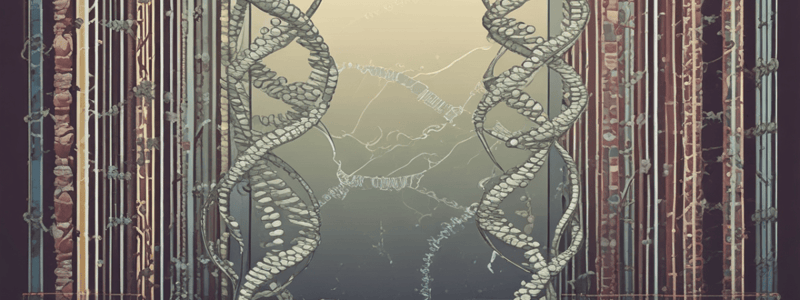Podcast
Questions and Answers
What is the purpose of telomeres in chromosomes?
What is the purpose of telomeres in chromosomes?
- To divide chromosomes
- To transcribe DNA to RNA
- To replicate chromosomes
- To protect chromosomes from damage (correct)
What occurs when telomeres get too short?
What occurs when telomeres get too short?
- DNA replication increases
- Cells stop dividing (correct)
- Cells divide continuously
- Telomeres get longer
What is a characteristic of cancer cells?
What is a characteristic of cancer cells?
- Low telomerase activity
- Short telomeres
- Long telomeres
- High telomerase activity (correct)
What is the primary function of transposons?
What is the primary function of transposons?
What is a characteristic of retrotransposons?
What is a characteristic of retrotransposons?
What percentage of the human genome is composed of mobile genetic elements and remnants?
What percentage of the human genome is composed of mobile genetic elements and remnants?
What is the purpose of using ddNTPs in the Sanger chain termination method?
What is the purpose of using ddNTPs in the Sanger chain termination method?
What is the main advantage of Next Generation Sequencing over traditional Sanger sequencing?
What is the main advantage of Next Generation Sequencing over traditional Sanger sequencing?
What is the primary factor determining the melting temperature of DNA?
What is the primary factor determining the melting temperature of DNA?
What is the term for the phenomenon where the size of an organism's genome does not correlate with its complexity?
What is the term for the phenomenon where the size of an organism's genome does not correlate with its complexity?
What is the approximate percentage of non-coding DNA in the human genome?
What is the approximate percentage of non-coding DNA in the human genome?
What is the term for the short, repetitive sequences found at telomeres and centromeres?
What is the term for the short, repetitive sequences found at telomeres and centromeres?
What is the enzyme responsible for adding telomere repeats to the ends of chromosomes?
What is the enzyme responsible for adding telomere repeats to the ends of chromosomes?
What is the primary function of centromeres in chromosomes?
What is the primary function of centromeres in chromosomes?
What is the majority of the non-coding DNA in the human genome composed of?
What is the majority of the non-coding DNA in the human genome composed of?
What is the main characteristic of segmental duplications in the human genome?
What is the main characteristic of segmental duplications in the human genome?
What is the function of centromeres in determining the structure of chromosomes?
What is the function of centromeres in determining the structure of chromosomes?
What type of DNA is found in large tandem arrays at centromeres?
What type of DNA is found in large tandem arrays at centromeres?
What is the location of tandem repeats in the human genome?
What is the location of tandem repeats in the human genome?
What is the repetitive sequence found in human telomeres?
What is the repetitive sequence found in human telomeres?
What type of DNA structure forms at the end of chromosomes?
What type of DNA structure forms at the end of chromosomes?
What is the point at which telomeres get too short and cells stop dividing?
What is the point at which telomeres get too short and cells stop dividing?
What is unique about the telomerase enzyme?
What is unique about the telomerase enzyme?
What is a characteristic of cancer cells?
What is a characteristic of cancer cells?
Flashcards are hidden until you start studying
Study Notes
Chain Termination Method
- Devised by Sanger, uses ddNTPs and dNTPs
- ddNTPs cannot be added onto as no OH group on 3’ carbon
- Replication randomly terminated at different points in four tubes with different ddNTPs
- Resolve by electrophoresis and label DNA fragments, determine sequence
Next Generation Sequencing
- Relies on massively parallel sequencing – sequence short reads (25-30bp)
- Reads are assembled into chromosomes/genomes by computers
- Rate of annealing gives information on complexity, composition, and size of genome
DNA Hybridisation
- DNA separation by raising temperature above melting temperature
- Depends on DNA length and ionic composition of solvent
- G:C rich higher melting point than AT rich
- De-natured strands can reanneal when fall below melting temperature
C-Value Paradox
- Lack of correlation between genome size and organism complexity
- Complex organisms tend to have larger genomes
- Lack of correlation between genome size and number of genes
Human Genome
- 98.5% of human genome = non-coding
- 25% = footprint of gene, 75% no known function
- Non-coding DNA contains sequence repeats – tandem repeats and interspersed repeats
- Interspersed repeats include mobile genetic elements like transposons and Alu repeats
Segmental Duplications
- 1-400kb, have high sequence identity, 5% of genome
- Include low-copy repeats
Telomeres and Centromeres
- Major regions of heterochromatin
- Centromere position determines length of arms of chromosomes
- Telomere DNA sequence = TTAGGG in humans, repeated about 1000 times
- Telomere added by telomerase = self-templating reverse transcriptase
Telomere Function
- T-LOOP closes off end of chromosomes
- QUADRUPLEX DNA = four GGG triplets forming stacked planar G quartets held by HOOGSTEEN HYDROGEN BONDS
- Stops chromosomes being damaged by cell
- HALYFLICK LIMIT = point where telomeres get too short, and cells stop dividing
- Introduction of telomerase allows continuation of division
- Cancers have elevated telomerase
Mobile Genetic Elements
- Many repetitive sequences derived from mobile genetic elements
- Cause mutations where they insert
- TRANSPOSONS are DNA that move around genome by TRANSPOSASE
- RETROTRANSPOSONS – DNA transcribed to RNA; RNA reverse transcribed to DNA which is inserted into a different part of the genome
- 45% of human genome = mobile genetic elements/remnants, most have lost mobility
- Transposons can cause muscular dystrophy and haemophilia but can be useful for evolution and immune system diversity
- RECOMBINASES that mediate antibody diversity generation are related to transposon-coded enzymes
Human Genome Composition
- The majority of the human genome, approximately 98.5%, is non-coding.
Function and Characteristics of Non-Coding DNA
- Only 25% of non-coding DNA has a known function, such as coding for lncRNA (long non-coding RNA) and miRNA, leaving 75% with unknown function.
- Non-coding DNA contains sequence repeats, including:
- Tandem repeats: short nucleotide stretches in a head-to-tail arrangement, primarily found at telomeres and centromeres.
- Interspersed repeats: mobile genetic elements that can move around the genome, including transposons and Alu repeats.
Segmental Duplications
- Segmental duplications, also known as low-copy repeats, are 1-400kb in length and have high sequence identity, covering approximately 5% of the genome.
Telomeres and Centromeres
- Telomeres and centromeres are major regions of heterochromatin.
- The position of the centromere determines the length of the arms of chromosomes.
- Centromeres contain large tandem arrays called satellite DNA, which is 171bp long.
Telomere Structure and Function
- Telomere DNA sequence in humans is TTAGGG, repeated approximately 1000 times.
- Telomeres protect chromosomes from damage by capping the ends, allowing for proper cell division.
Telomere Maintenance
- Telomeres are added by telomerase, a self-templating reverse transcriptase that uses RNA as a template for DNA synthesis.
- Telomeraseallows for the extension of telomeres, which would otherwise shorten with each cell division.
Telomere Protection Mechanism
- The T-LOOP structure at the end of chromosomes is formed, which prevents chromosomes from being damaged by the cell.
- Quadruplex DNA, consisting of four GGG triplets, forms stacked planar G quartets held together by Hoogsteen hydrogen bonds, ensuring chromosome stability.
Telomere Limitations
- The Hayflick limit is the point at which telomeres become too short, and cells stop dividing.
- Introduction of telomerase can overcome the Hayflick limit, allowing cells to continue dividing.
Telomerase and Cancer
- Cancers are characterized by elevated levels of telomerase, enabling unlimited cell division and contributing to tumor growth.
Studying That Suits You
Use AI to generate personalized quizzes and flashcards to suit your learning preferences.




